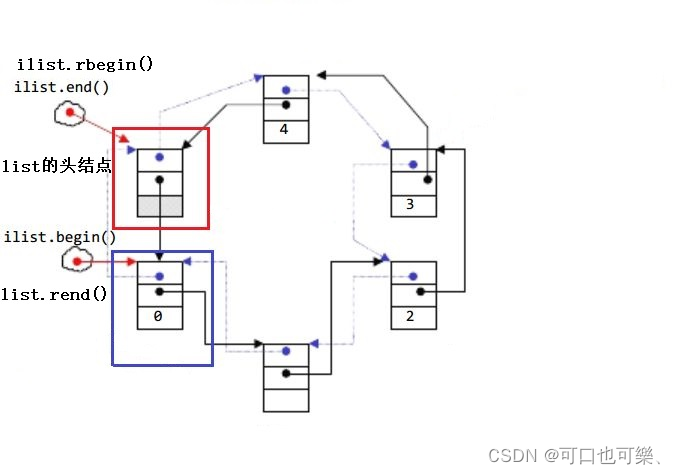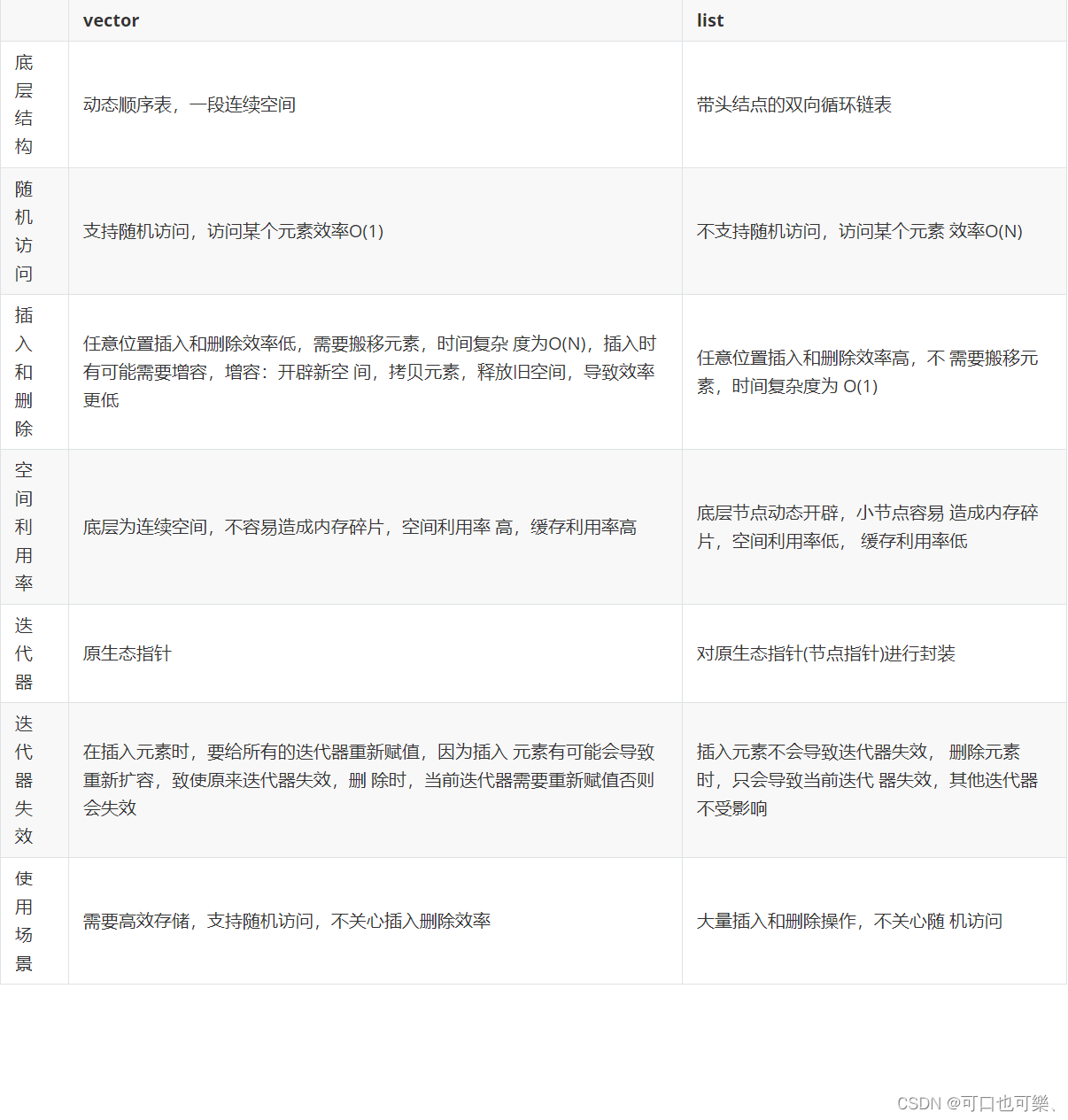
【C++初阶学习】C++list的使用及模拟
零、前言
本章主要讲解C++中的容器list的使用以及模拟实现
一、什么是list
- list的介绍:
list的底层是双向链表结构,双向链表中每个元素存储在互不相关的独立节点中,在节点中通过指针指向其前一个元素和后一个元素
list与forward_list(单链表)的操作非常相似,但单链表只能朝前迭代
- 优劣:
list是可以在常数范围内在任意位置进行插入和删除的序列式容器,并且该容器可以前后双向迭代
对于链表与其他序列式容器相比,list和forward_list最大的缺陷是不支持任意位置的随机访问(不是连续开辟的动态空间)
- 示图:

二、list的常用接口说明
注:以下为list中一些常见的重要接口
1、list对象常用构造
| 构造函数( (constructor)) | 接口说明 |
|---|---|
| list() | 构造空的list |
| list (size_type n, const value_type& val = value_type()) | 构造的list中包含n个值为val的元素 |
| list (const list& x) | 拷贝构造函数 |
| list (InputIterator first, InputIterator last) | 用[first, last)区间中的元素构造list |
- 使用示例:
void test_list1()
{
list<int> l1; // 构造空的l1
list<int> l2(4, 100); // l2中放4个值为100的元素
list<int> l3(l2.begin(), l2.end()); // 用l2的[begin(), end())左闭右开的区间构
list<int> l4(l3); // 用l3拷贝构造l4
// 以数组为迭代器区间构造l5
int array[] = { 16,2,77,29 };
list<int> l5(array, array + sizeof(array) / sizeof(int));
// 用迭代器方式打印list中的元素
for (list<int>::iterator it = l2.begin(); it != l2.end(); it++)
cout << *it << " ";
cout << endl;
for (list<int>::iterator it = l4.begin(); it != l4.end(); it++)
cout << *it << " ";
cout << endl;
// C++11范围for的方式遍历
for (auto& e : l5)
cout << e << " ";
cout << endl;
}
- 结果:

2、list对象属性及迭代器使用
| 函数声明 | 接口说明 |
|---|---|
| empty | 检测list是否为空,是返回true,否则返回false |
| size | 返回list中有效节点的个数 |
| front | 返回list的第一个节点中值的引用 |
| back | 返回list的最后一个节点中值的引用 |
| begin+end | 返回第一个元素的迭代器+返回最后一个元素下一个位置的迭代器 |
| rbegin+rend | 返回第一个元素的reverse_iterator,即end位置,返回最后一个元素下一个位置的 reverse_iterator,即begin位置 |
- 迭代器示图:

- 注意:
begin与end为正向迭代器,对迭代器执行**++**操作,迭代器向后移动
**rbegin(end)与rend(begin)为反向迭代器,对迭代器执行++**操作,迭代器向前移动
list的迭代器并不是原生指针,而是经过封装的指针(后续模拟会提及)
- 使用示例:
void print_list(const list<int>& l)
{
// 注意这里调用的是list的 begin() const,返回list的const_iterator对象
for (list<int>::const_iterator it = l.begin(); it != l.end(); ++it)
{
cout << *it << " ";
// *it = 10; 编译不通过(const迭代器不能修改指向内容)
}
cout << endl;
}
void test_list2()
{
int array[] = { 1, 2, 3, 4, 5, 6, 7, 8, 9, 0 };
list<int> l(array, array + sizeof(array) / sizeof(array[0]));
// 使用正向迭代器正向list中的元素
for (list<int>::iterator it = l.begin(); it != l.end(); ++it)
cout << *it << " ";
cout << endl;
// 使用反向迭代器逆向打印list中的元素
for (list<int>::reverse_iterator it = l.rbegin(); it != l.rend(); ++it)
cout << *it << " ";
cout << endl;
cout << l.size() << endl;
cout << l.empty() << endl;
cout << l.front() << endl;
cout << l.back() << endl;
}
- 结果:

3、list对象修改操作
| 函数声明 | 接口说明 |
|---|---|
| push_front | 在list首元素前插入值为val的元素 |
| pop_front | 删除list中第一个元素 |
| push_back | 在list尾部插入值为val的元素 |
| pop_back | 删除list中最后一个元素 |
| insert | 在list position 位置中插入值为val的元素 |
| erase | 删除list position位置的元素 |
| swap | 交换两个list中的元素 |
| clear | 清空list中的有效元素 |
- 使用示例:
void PrintList(list<int>& l)
{
for (auto& e : l)
cout << e << " ";
cout << endl;
}
void test_list3()
{
//push_back/pop_back/push_front/pop_front
int array[] = { 1, 2, 3 };
list<int> L(array, array + sizeof(array) / sizeof(array[0]));
// 在list的尾部插入4,头部插入0
L.push_back(4);
L.push_front(0);
PrintList(L);
// 删除list尾部节点和头部节点
L.pop_back();
L.pop_front();
PrintList(L);
//insert/erase
int array1[] = { 4,5,6 };
list<int> L1(array1, array1 + sizeof(array1) / sizeof(array1[0]));
// 获取链表中第二个节点
auto pos = ++L1.begin();
cout << *pos << endl;
// 在pos前插入值为4的元素
L1.insert(pos, 4);
PrintList(L1);
// 在pos前插入5个值为5的元素
L1.insert(pos, 5, 5);
PrintList(L1);
// 在pos前插入[v.begin(), v.end)区间中的元素
vector<int> v{ 7, 8, 9 };
L1.insert(pos, v.begin(), v.end());
PrintList(L1);
// 删除pos位置上的元素
L1.erase(pos);
PrintList(L1);
// 删除list中[begin, end)区间中的元素,即删除list中的所有元素
L1.erase(L1.begin(), L1.end());
PrintList(L1);
//resize/swap/clear
// 用数组来构造list
int array2[] = { 7,8,9 };
list<int> l2(array1, array1 + sizeof(array1) / sizeof(array1[0]));
PrintList(l2);
// 交换l1和l2中的元素
L1.swap(l2);
PrintList(L1);
PrintList(l2);
// 将l2中的元素清空
l2.clear();
cout << l2.size() << endl;
}
- 结果:

4、list迭代器失效问题
list的底层结构为带头结点的双向循环链表,因此在list中进行插入时是不会导致list的迭代器失效的,只有在删除时才会失效,并且失效的只是指向被删除节点的迭代器,其他迭代器不会受到影响
- 示例:
void TestListIterator1()
{
int array[] = { 1, 2, 3, 4, 5, 6, 7, 8, 9, 0 };
list<int> l(array, array + sizeof(array) / sizeof(array[0]));
auto it = l.begin();
while (it != l.end())
{
// erase()函数执行后,it所指向的节点已被删除,因此it无效,在下一次使用it时,必须先给其赋值
l.erase(it);
++it;
}
PrintList(l);
}
// 改正
void TestListIterator2()
{
int array[] = { 1, 2, 3, 4, 5, 6, 7, 8, 9, 0 };
list<int> l(array, array + sizeof(array) / sizeof(array[0]));
auto it = l.begin();
while (it != l.end())
{
l.erase(it++);
//it=l.erase(it);
}
PrintList(l);
}
void TestListIterator3()
{
int array[] = { 1, 2, 3 };
list<int> l(array, array + sizeof(array) / sizeof(array[0]));
auto it = l.begin();
while (it != l.end())
{
//insert后it迭代器的意义不会改变
l.insert(it,4);
++it;
}
PrintList(l);
}
- 结果:

三、list剖析和模拟实现
1、list迭代器封装和节点类
- 迭代器有两种实现方式,具体应根据容器底层数据结构实现:
原生态指针,比如:vector,string
将原生态指针进行封装,因迭代器使用形式与指针完全相同(使用重载进行封装指针,达到迭代器的效果)
- 封装方法:
指针可以解引用,迭代器的类中必须重载operator*()
指针可以通过->访问其所指空间成员,迭代器类中必须重载oprator->()
指针可以++向后移动,迭代器类中必须重载operator++()与operator++(int)至于operator–()/operator–(int)释放需要重载,根据具体的结构来抉择,双向链表可以向前移动,所以需要重载,如果是forward_list就不需要重载–
迭代器需要进行是否相等的比较,因此还需要重载operator==()与operator!=()
- 实现代码:
// List的节点类
template<class T>
struct ListNode
{
ListNode(const T& val = T())
:_val(val)
,_pPre(nullptr)
,_pNext(nullptr)
{}
//成员变量
ListNode<T>* _pPre;
ListNode<T>* _pNext;
T _val;
};
//List的迭代器类(Ref(T&),Ptr(T*))
//(封装迭代器,使原生指针能执行迭代器基本操作)
template<class T, class Ref, class Ptr>
struct ListIterator
{
typedef ListNode<T>* PNode;
typedef ListIterator<T, Ref, Ptr> Self;
ListIterator(PNode pNode = nullptr)
:_pNode(pNode)
{}
Ref operator*()
{
return _pNode->_val;
}
Ptr operator->()
{
return &_pNode->_val;
}
Self& operator++()
{
_pNode = _pNode->_pNext;
return *this;
}
Self operator++(int)
{
Self tmp(_pNode);
_pNode = _pNode->_pNext;
return tmp;
}
Self& operator--()
{
_pNode = _pNode->_pPre;
return *this;
}
Self operator--(int)
{
Self tmp(_pNode);
_pNode = _pNode->_pPre;
return tmp;
}
bool operator!=(const Self& l)const
{
return _pNode != l._pNode;
}
bool operator==(const Self& l)const
{
return _pNode == l._pNode;
}
PNode _pNode;
};
注:这里的节点类和迭代器类,我们希望能直接被list类访问使用,使用struct默认访问限定类型为public
2、list常用接口实现
- 实现代码:
//list类
template<class T>
class list
{
typedef ListNode<T> Node;
typedef Node* PNode;
public:
typedef ListIterator<T, T&, T*> iterator;
typedef ListIterator<T, const T&, const T&> const_iterator;
// List的构造
list()
:_pHead(new Node)//构建哨兵节点
{
_pHead->_pNext = _pHead;
_pHead->_pPre = _pHead;
}
list(int n, const T& value = T())
{
_pHead = new Node;
_pHead->_pNext = _pHead;
_pHead->_pPre = _pHead;
while (n--)
{
push_back(value);
}
}
template <class Iterator>
list(Iterator first, Iterator last)
{
_pHead = new Node;
while(first!=last)
{
push_back(*first);
++first;
}
}
list(const list<T>& l)
{
_pHead = new Node;
_pHead->_pNext = _pHead;
_pHead->_pPre = _pHead;
const_iterator it = l.begin();
while (it != l.end())
{
push_back(*it);
++it;
}
}
list<T>& operator=(list<T> l)//现代式
{
swap(_pHead, l._pHead);
return *this;
}
~list()
{
clear();
delete _pHead;
_pHead = nullptr;
}
// List Iterator
iterator begin()
{
return iterator(_pHead->_pNext);//迭代器封装指针
}
iterator end()
{
return iterator(_pHead);
}
const_iterator begin()const
{
return const_iterator(_pHead->_pNext);
}
const_iterator end()const
{
return const_iterator(_pHead);
}
// List Capacity
size_t size()const
{
size_t sz = 0;
iterator it = begin();
while (it != end())
{
++it;
++sz;
}
return sz;
}
bool empty()const
{
return begin() == end();
}
// List Access
T& front()
{
assert(!empty());
return _pHead->_pNext->_val;
}
const T& front()const
{
assert(!empty());
return _pHead->_pNext->_val;
}
T& back()
{
assert(!empty());
return _pHead->_pPre->_val;
}
const T& back()const
{
assert(!empty());
return _pHead->_pPre->_val;
}
// List Modify
void push_back(const T& val)
{
insert(end(), val);
}
void pop_back()
{
erase(--end());
}
void push_front(const T& val)
{
insert(begin(), val);
}
void pop_front()
{
erase(begin());
}
// 在pos位置前插入值为val的节点
iterator insert(iterator pos, const T& val)
{
assert(pos._pNode);
PNode cur = pos._pNode;
PNode pre = cur->_pPre;
PNode newnode = new Node(val);
newnode->_pNext = cur;
cur->_pPre = newnode;
pre->_pNext = newnode;
newnode->_pPre = pre;
return iterator(newnode);
}
// 删除pos位置的节点,返回该节点的下一个位置
iterator erase(iterator pos)
{
assert(pos._pNode);
assert(pos!=end());
PNode pre = pos._pNode->_pPre;
PNode next = pos._pNode->_pNext;
pre->_pNext = next;
next->_pPre = pre;
delete pos._pNode;
return iterator(next);
}
void clear()
{
iterator it = begin();
while (it != end())
{
it = erase(it);
}
}
private:
PNode _pHead;
};
3、list和vector对比
vector与list都是STL中非常重要的序列式容器,由于两个容器的底层结构不同,导致其特性以及应用场景不同
- 对比展示:
